Dalhousie University
| Dalhousie University | |
|---|---|
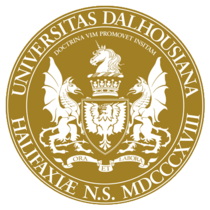 |
|
| Motto | Latin: Ora et Labora (English: Pray and work) |
| Established | 1818 |
| Type | Public |
| Religious affiliation | Non-denominational |
| Endowment | $337.7 million[1] (end of fiscal 2008). |
| Chancellor | Fred Fountain |
| President | Tom Traves |
| Undergraduates | 12,060 |
| Postgraduates | 3,460 |
| Location | Halifax, Nova Scotia, Canada |
| Campus | Urban |
| Colours | black & gold |
| Mascot | Tigers |
| Affiliations | AUCC, CARL, IAU, ACU, CBIE, CIS, CUSID, AUS, |
| Website | http://www.dal.ca/ |
 |
|
Dalhousie University is a university located in Halifax, Nova Scotia, Canada. Founded in 1818, Dalhousie is one of Canada's oldest universities. As the largest post-secondary educational institution in the Maritime Provinces it offers a wide array of programs, including Dalhousie Medical School, the Schulich School of Law, and the separate Sexton Campus for architecture, urban and regional planning, and engineering. The chancellor is Mr. Fred Fountain; Dr. Tom Traves serves as president and vice-chancellor.
Dalhousie is consistently named among Canada's top research universities. It is a member of the Group of Thirteen, more commonly referred to as the G13, a group of the leading research universities in Canada.
In 2003 and 2004, The Scientist magazine placed Dalhousie among the top five places in the world, outside the United States, for postdoctoral work and conducting scientific research.[2] In 2007 Dalhousie topped the list of The Scientist’s “Best Places to Work in Academia”. The annual list divides research and academic institutions into American and international lists; Dalhousie University is ranked first in the international category.[3] According to a survey conducted by The Scientist magazine, Dal was named the best non-commercial scientific institute in which to work in Canada.[4]
Dalhousie University was ranked as the seventh-best university (Medical Doctoral Rankings) in Canada by Maclean's Magazine in 2009.[5] In addition, Maclean's ranked Dalhousie's law school sixth overall for two consecutive years.[6][7] In the 2008 edition of the annual Times Higher Education Supplement-Quacquarelli Symonds World University Rankings, Dalhousie ranked 11th in Canada and 197th internationally.[8] The first ever Global University Ranking (2009), compiled by a Russian organization that ranks the top 500 global universities [9] places Dalhousie at 180th in the world, and 8th in Canada [10]
Contents |
History
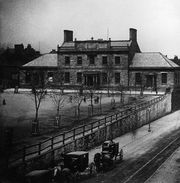
Dalhousie College was founded in 1818 as a non-denominational university by the 9th Earl of Dalhousie, at the time the Governor of Nova Scotia.[11] Dalhousie University awarded its first BA in 1866.
Using money acquired from the duties collected during the occupation Castine Maine and other parts of the state in the War of 1812, Ramsay established Dalhousie as a college open to all people regardless of class or creed. At the laying of the cornerstone on May 22, 1820, Lord Dalhousie said that this University was "founded on the principles of religious tolerance." Dalhousie remained one of only three universities founded on secular constitutional premises until as late as the 1950s. Although it was technically founded in 1818, Dalhousie did not have its first students until November 1, 1838. However, following the death of the University's first principal, Thomas McCulloch, in 1843 the school was once again allowed to fall into inactivity. Dalhousie did not permanently open its door again until November 10, 1863.
In 1876 the experiment was commenced in Halifax, Nova Scotia of a University to hold examinations in arts, law, and medicine, and to confer degrees.[12]
Dalhousie was distinctive as an urban institution, situated in downtown Halifax on the site of the present City Hall. This status was seen not only, in the early days at least, in the use of much of the college's lowest floor as vault space for Oland Brewery, but also in the consistent drawing of about one-third of the student body from the city and in the college's ability to draw upon local professional populations in the establishment of professional faculties such as the Dalhousie University Faculty of Medicine (1868) and law (1883). Finances remained difficult into the 1880s, but by the end of that decade the accumulated donations of the philanthropist George Munro, brother-in-law of Board of Governors member John Forrest, had provided the stimulus that led to growth in student numbers and the emergence of Dalhousie as a centre of scholarship acknowledged throughout the dominion.
Dalhousie's colours of black and gold come from the jerseys worn by the Dalhousie University Rugby Football Club (who still wear those colours, as well as the school crest on their jerseys).
The Halifax Conservatory became affiliated with Dalhousie in 1889.[11]

In 1920 the University of King's College in Windsor, Nova Scotia, English Canada's oldest degree granting institution, burned down. Through a grant from the Carnegie Foundation, King's College was able to relocate to Halifax and entered into a partnership with Dalhousie University. While often seen as a separate but integrated institution, King's shares Dalhousie's Arts and Sciences Faculty, but offers several interdisciplinary humanities degree programmes, such as Contemporary Studies, History of Science and Technology and Early Modern Studies.
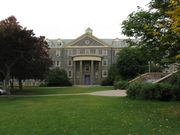
In 1936, the Institute of Public Affairs was established at Dalhousie University.
Dalhousie University features several stained glass windows including a `poetry and prose` window in the Dalhousie College library and a Medallion window in Sheriff Memorial Hall by Robert McCausland Limited.
Dalhousie expanded its presence in south-end Halifax during the 1960s and 1970s when it built the Dalplex athletic facility, the Killam Library, the Life Sciences Centre, the Dalhousie Student Union building and a district heating plant, all on what is referred to as the Studley Campus (the main campus). Also at this time, Dalhousie built the Tupper Building for its Dalhousie Medical School and expanded existing buildings to house the Faculty of Dentistry and College of Pharmacy, all on the adjacent Carleton Campus, located immediately to the east of the Studley Campus, and co-located with two of Halifax's teaching hospitals (the Victoria General Site of the Queen Elizabeth II Health Sciences Centre and the IWK Health Centre for Women, Children, and Youth).
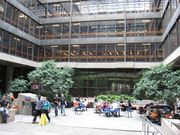
Nova Scotia Technical College (1907-1997), also located in Halifax, was originally set up to offer the final years of an "associated" engineering education. It launched its program in architecture in 1961. Nova Scotia Technical College was later renamed the Technical University of Nova Scotia (TUNS) in 1980.[13] Following a period of government-mandated consolidation of post-secondary institutions during the 1990s, the Technical University of Nova Scotia was merged with Dalhousie University in 1997. It was initially known as Dalhousie University Polytechnic, or DalTech, but in 2000 the DalTech nickname was dropped and the engineering, architecture and computer science faculties of TUNS were fully integrated into Dalhousie University. The Faculty of Engineering and the Faculty of Architecture and Planning are located on the Sexton Campus, east of the Carleton Campus and closer to downtown Halifax. The Faculty of Computer Science moved to its own building, the Goldberg Computer Science Building on Studley Campus, in 1999.
Among North American universities, only Harvard, Yale, Princeton, McGill and the University of Toronto boast more Rhodes Scholars than Dalhousie.
Faculties
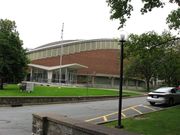
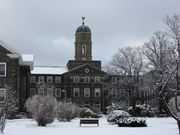
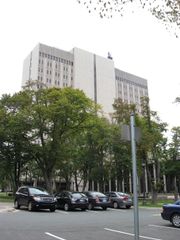
Dalhousie comprises eleven faculties:
- Architecture and Planning
- Arts and Social Sciences
- Computer Science
- Dentistry
- Engineering Students can specialize in the following disciplines: Biological Engineering, Chemical Engineering, Civil Engineering, Electrical Engineering, Food Science, Industrial Engineering, Mechanical Engineering, Materials Engineering and Mining Engineering [14]
- Graduate Studies
- Health Professions
- Law
- Management
- Medicine
- Science
Campus life
Dalhousie's campus newspaper, the Dalhousie Gazette, was founded in 1868, making it the oldest student newspaper in Canada and one of the oldest continuously-running student newspapers in North America.
Notable among a number of songs commonly played and sung at various events such as commencement and convocation, and athletic games are: Carmina Dalhousiana (Halifax 1882).[15]
The first Friday in February of each year is Munro Day, a holiday celebrating financial contributions made to the school in its infancy by George Munro [16].
Athletics
The University’s Department of Athletics and Recreational Services is represented in Atlantic University Sport (AUS) competition by the Dalhousie Tigers. Dalhousie has 14 varsity teams, including men’s and women’s teams in cross country, soccer, track and field, basketball, hockey, volleyball and swimming. Representing these teams are over 300 athletes, coaches, trainers and managers.
Since 1990, the Dalhousie Tigers have brought home 127 AUS championships, five Canadian Interuniversity Sport (CIS) team championships and numerous individual national medals. During the 2007-08 varsity season the Tigers captured six AUS championships including: men’s cross country, men’s volleyball, men’s swimming, women’s swimming, men’s track and field, and women’s track and field.
Dalhousie also has dozens of intramural and club sports, from rock climbing and rugby to field hockey and sailing.
Fight song
Notable among a number of songs commonly played and sung at various events such as commencement and convocation, and athletic games are: "Carmina Dalhousiana" (Halifax 1882). The Dalhousie University Song-book was compiled by Charles B. Weikel [Halifax 1904] [17]
Facilities
Dalhousie University is spread over three campuses on the Halifax peninsula, all within walking distance of one another. The largest, the Studley Campus, was originally designed by Andrew R. Cobb. It is generally rectangular in shape, and is bounded by Coburg Street to the north, Robie Street to the east, South Street to the south, and Oxford Street to the west. University Avenue acts as the main thoroughfare.
Studley Campus is the main campus for undergraduate studies in the arts, social sciences, and sciences, as well as being the home of the first-year engineering program and the law school. Its wide range of facilities include the Henry Hicks Academic Administration building, the Killam Library, the Life Sciences Centre, the Marion McCain Arts and Social Sciences building, the Kenneth C. Rowe Management building, the Student Union building (commonly called the SUB), and a new academic building currently under construction with an expected completion date of 2010.
Directly to the east of the Studley Campus, beyond Robie Street, is the Carleton Campus. It is home to the Dalhousie Medical School, Dentistry, and Health Professions, including the departments of pharmacology, nursing, and occupational therapy.
Further east, on Barrington Street, downtown, is the Sexton Campus. Originally the Technical University of Nova Scotia (until 1997), it is home to the Faculty of Architecture and Planning and the Faculty of Engineering.
Current issues
Dalhousie's preliminary enrolment for 2007-08 consists of 10,254 full-time undergraduate students and 2,793 full-time graduate students[18]. Dalhousie has balanced 20 straight budgets, but like many of Canada's universities, is facing long-term challenges in deferred maintenance.
The university is going through a building phase. A new building for the Faculty of Computer Science opened in October 1999 followed shortly thereafter by the Marion McCain Arts and Social Sciences Building. The Howe Hall residence was expanded with the addition of Fountain House and a new residence was also built, named John Risley Hall. The Kenneth C. Rowe Management Building opened in October 2005. The university is presently constructing the New Academic Building on Coburg Road, and has received $15 million from the federal government towards the present construction of the new Life Sciences Research Institute, which the university will share with project partners Capital Health and the IWK Health Centre.

On March 6 and 7 2007, the Dalhousie Student Union held a referendum on a plan from the university administration which proposed the addition of new student areas and the renovation of existing spaces across the Dalhousie campus[19]. The final vote was No, with 57.3% of voters agreeing that the proposed improvements were unnecessary or should not be funded solely by student dollars. Had the referendum succeeded, the construction and renovations would have been funded through an increase in student fees of $10.00 per course, reaching a maximum of $100 per year, for several decades.
Dalhousie University has launched Canada's only Corporate Residency MBA (Dalhousie Corporate Residency MBA). It is a 22-month program integrating North American employers into the academic process, providing students with paid work experience and leadership development skills.[20].
Dalhousie is noted as one the top research facilities in Canada and was ranked number 8 for its category in Maclean's for the year of 2007.[4]
Notable people
Notable Dalhousie alumni include prime ministers of Canada: R.B. Bennett, Joe Clark and Brian Mulroney; well-known authors:Ernest Buckler, Lucy Maud Montgomery, Hugh MacLennan, Sandra Gwyn, Simon Gray; provincial premiers: Alex Campbell, Richard Hatfield, Gerald Regan, John Buchanan, Joe Ghiz, and Danny Williams; renowned scientists: D.O. Hebb, Martin Henry Dawson; the first woman to be appointed to the Supreme Court of Canada: Bertha Wilson; the first American woman to walk in space: Kathryn D. Sullivan; business leaders: Charles Peter McColough, Sean Durfy; artists and entertainers: Barbara Fris, Shaun Majumder, Chris Murphy: leaders of national political parties: Robert Stanfield, Peter MacKay, Alexa McDonough, Elizabeth May, and other notable political figures: Jim Prentice, John Crosbie, Anne McLellan, Gerry Byrne, Scott Brison, and Peter Milliken.
See also
- Dalhousie Student Union
- Schulich School of Law
- Dalhousie Tigers - varsity athletics teams
- Fenwick Place
- Fraternities and sororities at Dalhousie University
- Dalhousie Arts Centre
- University of King's College
- Canadian Interuniversity Sport
- Canadian government scientific research organizations
- Canadian university scientific research organizations
- Canadian industrial research and development organizations
- List of agricultural universities and colleges
- List of universities with industrial engineering faculty
- List of colleges and universities named after people
- Higher education in Nova Scotia
- List of universities in Nova Scotia
Histories of the University
- Heather Alder 'The Lives of Dalhousie University, Vol. 1: Lord Dalhousie's College, 1818-1925' (Montreal: McGill-Queen's University Press, January 6, 1994)
- Dr. Peter Busby Waite, PhD. Professor Emeritus 'The Lives of Dalhousie University' Vol I (Montreal: McGill-Queen's University Press, 1994)
- Dr. Peter Busby Waite, PhD. Professor Emeritus 'The Lives of Dalhousie University' Vol II (Montreal: McGill-Queen's University Press, 1998)
- Henry Roper and James W. Clark. "Religion and Intellectual Freedom on the Dalhousie Campus in the 1920s: The Case of Norman J. Symons." Dalhousie Review 69, no. 2 (Spring 1989).
References
- ↑ Vice-President (Finance and Administration) Investment Performance Notice (June 28, 2006). [1]. Retrieved March 19, 2009.
- ↑ Dalhousie Research
- ↑ [2]
- ↑ Dalhousie Communication and Marketing
- ↑ [3]
- ↑ "Canadian Law School Rankings". Top-Law-Schools.com. http://www.top-law-schools.com/canadian-law-school-rankings.html.
- ↑ "Overall ranking: Macleans OnCampus". Maclean's. http://oncampus.macleans.ca/education/2008/09/11/overall-ranking/.
- ↑ THES. "2008 THES QS World University Rankings". http://www.topuniversities.com/university_rankings/results/2008/overall_rankings/fullrankings/. Retrieved 2008-10-23.
- ↑ http://www.globaluniversitiesranking.org/index.php?option=com_content&view=article&id=63&Itemid=66/
- ↑ http://www.globaluniversitiesranking.org/images/banners/top-200(eng).pdf
- ↑ 11.0 11.1 Dalhousie University
- ↑ http://www.gutenberg.org/dirs/etext04/tlctd10.txt The Project Gutenberg EBook #6466 of 'The Intellectual Development of the Canadian People, A historical review' by John George Bourinot, House of Commons, Ottawa, February 17th, 1881
- ↑ Architectural Education
- ↑ Canadian Engineering Memorial Foundation - University List
- ↑ Dalhousie University Song-book, compiled by Charles B. Weikel [Halifax 1904] http://www.thecanadianencyclopedia.com/index.cfm?PgNm=TCE&Params=U1ARTU0000759SUBReadings
- ↑ The man behind Munro Day, DalNews
- ↑ http://www.thecanadianencyclopedia.com/index.cfm?PgNm=TCE&Params=U1ARTU0000759SUBReadings Fight Songs
- ↑ Association of Atlantic Universities (2007). Survey of Preliminary Enrolments as of October 1, 2007. Retrieved December 11, 2007.
- ↑ Dalhousie News (2007). Dalhousie News - A chance to shape Dalhousie for the better.
- ↑ Dalhousie MBA Program
External links
- Dalhousie University
- The Buildings of Dalhousie
- Dalhousie Gazette - Student Newspaper
- Webcam views of Dalhousie
- Dalhousie University Faculty of Computer Science
- Dalhousie University School of Biomedical Engineering
- DSU Events Posting
- CKDU - Listen online
- Dalhousie Law School
- Dalhousie Academic Timetable
- Review of The Lives of Dalhousie University
- The Earls of Dalhousie
- Dalhousie Senior Administration Salaries
- Dalhousie Athletic & Recreational Services
- Dalhousie University Faculty of Medicine
|
|||||
|
|||||||||
|
||||||||||||||||||||||
|
||||||||